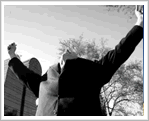IRON RING

The Ritual of the Calling of an Engineer, an Archaic
Symbol or a Meaningful Commitment ![]()
BY JOHN R.
MCDOUGALL, P.Eng
The Ritual of the Calling of the Engineer was established in Canada in 1925. Since that time, 24 Camps have been formed across Canada and the awarding of the engineer's ring has been a symbol of the engineering profession in Canada.
Like many established symbols, in recent years, the iron ring ceremony has come under criticism. It is viewed by some as sexist and by others as archaic. Some argue that the ceremony should be public. Others suggest it relies excessively on Judeo - Christian principles. Some feel that language should be changed to reflect current times by eliminating any reference to gender or to God. Others simply state that the overall tone is inappropriate for these enlightened times.
On the morning of the Ring Ceremony, APEGGA holds a workshop which allows students the opportunity to meet and discuss ethical issues with professional members of APEGGA. Four case studies are evaluated. The cases present registration, compliance, ethics and investigative issues of interest to our professions.
Most engineers who have received the ring feel that the ceremony meets its goal in that it gives pause for sober thought about our profession and the responsibilities we have for the public. They understand and value the ceremony. At the very least, its tone challenges the self centered thinking that characterizes many of today's vested interest groups. I know that each time I participate in the ceremony, I reconsidered my role in society and the obligations I have accepted as an engineer.
Just as the ritual is symbolic, so is the ring itself. The ring represents an engineer's personal obligation to work for the betterment of society. The ritual suggests that engineer's rings should be returned to their Camp upon retirement or death. The fact that this rarely happens is not important. What is important is that engineers who wear the ring know what it represents and remember their commitment. While some families choose to retain the ring in memory of a deceased engineer, this should be discouraged. It is important that an engineer's ring not be worn by non-engineers or retained simply as a keepsake. It is a symbol of the engineer's obligation to society and, as such, should not be trivialized.
The symbolism of the ring ceremony is important. It reminds engineers of their obligation to the public good and to the strong moral tenets that characterize professional engineers. The choice of the literature used during the ceremony was made by Rudyard Kipling. It was presumably based in part on the character of the times, and in part based on the desire to reflect certain moral aspirations and thoughts. Those aspirations remain every bit as noble today as they were 70 years ago and they reflect a goal to which every engineer should continue to aspire.
That is the value of the ceremony and the obligation and the reason why the heritage of the iron ring ceremony should be valued and preserved.
CONTACTS:
CALGARY
Hugh
Savage, P. Eng.
Email: iron-ring@shaw.ca
Website: www.ironring.ca
Replacement Rings:
Ashley Pessell
Email: apessell@apegga.org
or by phone at 262-7714 between
8:30 a.m. and 4:30 p.m.
EDMONTON
Glen Sutton, P.Eng.
Tel: (780) 420-7675
Fax: (780) 420-3666
Cell: (780) 918-6573
Email: glen.sutton@atcoelectric.com
Website: www.ironring.ca
Replacement
Rings:
Contact Cathy Cavanagh for ring replacements at 420-7747 between 11:00 and 4:00,
or Glen Sutton, P.Eng at 420-7675. Replacement rings cost $20. Obligated
engineers from other Camps may have their rings replaced through Camp 6, however
eligibility will need to be confirmed with the original obligating Camp
